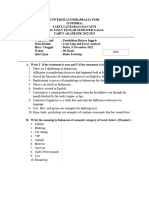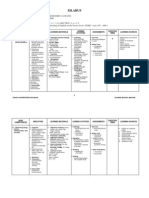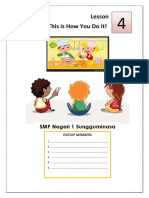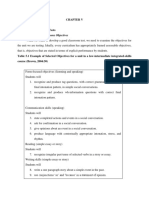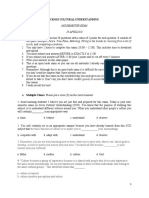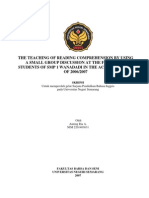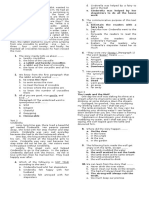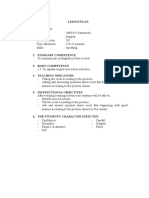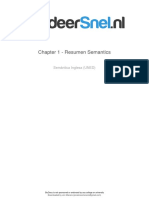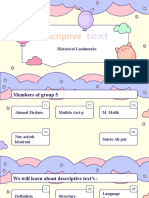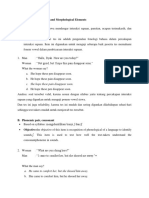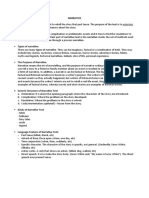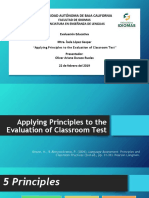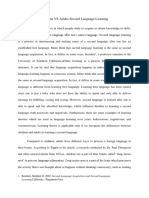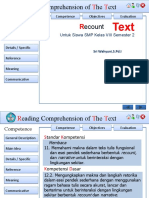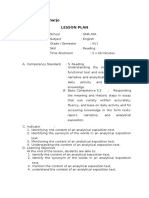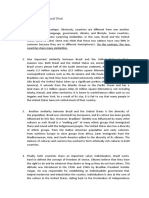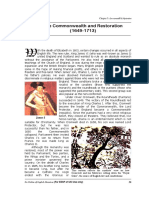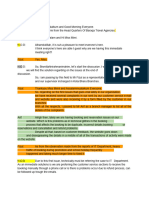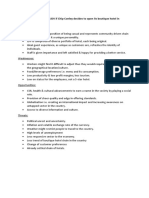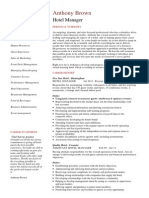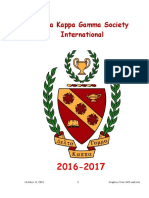Need Analysis For Waiter
Uploaded by
Jonathan AlexanderNeed Analysis For Waiter
Uploaded by
Jonathan AlexanderThe purpose of need analysis itself according to Richards (2001) is to find out what language skills the
learners need in order to perform a particular role, to help determining if an existing course adequately
addresses the needs of potential students, to determine which students from a group are most in need
of training in particular language skills, and to collect information about particular problem learners are
experiencing. This means needs analysis can be used for determining which people that have potential
and which one does not have, and the people who had potentials can be trained to develop their
language skills.
Need Analysis Approaches There are two main approaches used in order to carry out a need analysis,
they are Target Situation Analysis (TSA) and Present Situation Analysis (PSA).
Target Situational Analysis (TSA) TSA can be defined as a study to seek out all information about
component condition in a target language that is being learned by ESP learners in the language learning
process. According to Dudley-Evans and St. John (1998) TSA “includes objective perceive and product-
oriented needs” (p. 124). Robinson (1991) described TSA as a need analysis that focuses on students’
needs at the end of language course.
Present Situational Analysis (PSA) PSA can be defined as a study to see current condition of the learners
in beginning of the language course. Robinson (1991) described PSA as a complement to TSA. The PSA
will display the learners’ levels of ability, the language-teaching establishment, the learners’ attitude
toward the language learning and students’ strangeness and weakness.
Need analysis approach Respondent questions
Why is the language needed
How will the langugage be used
What will the content areas be
Who will the learner use the language
with
Where will the language be used
When will the language be used
Do you need English language skills in
your work? If there is please explain.
What activities require English language
skills in your field of work?
What English skills are used more in your
field of work? (reading, writing, listening
or speaking)?
How often do you meet foreign guests?
Is there a specific English standard for use
in hotels if you speak to guests?
What obstacles do you face in handling
foreign guests?
Most foreign tourists come from which
country?
Do different countries cause different
difficulties?
Have you ever experienced
miscommunication with foreign guests?
If there are juniors who handle foreign
guests, what is their difficulty usually?
Does the hotel provide special English
training for restaurant employees?
If we offer to give you English language
training for restaurant employees, will
you be willing to take part?
You might also like
- Oxford Exam Trainer B1 Progress Test Unit 3 A + B0% (1)Oxford Exam Trainer B1 Progress Test Unit 3 A + B8 pages
- The Collection of Language Assessment IndicatorsNo ratings yetThe Collection of Language Assessment Indicators16 pages
- UTS Contrastive Language and Error Analysis 2022-2023 SORENo ratings yetUTS Contrastive Language and Error Analysis 2022-2023 SORE2 pages
- KD 3.17 Lesson Plan KD 3.17: IndicatorsNo ratings yetKD 3.17 Lesson Plan KD 3.17: Indicators21 pages
- Soal UAP Dictation Gasal 2122 - Non RegulerNo ratings yetSoal UAP Dictation Gasal 2122 - Non Reguler3 pages
- Mobility and Friendship: (Đ NG Nghĩa) - Friendliness Is Characterized Much of American Daily Interaction But Is NotNo ratings yetMobility and Friendship: (Đ NG Nghĩa) - Friendliness Is Characterized Much of American Daily Interaction But Is Not2 pages
- A Word and Its Part Roots, Affixes, and Their Shapes Adriansyah75% (4)A Word and Its Part Roots, Affixes, and Their Shapes Adriansyah2 pages
- Recognizing Phonological and Morphological Elements A. Phonemic Pair, VowelsNo ratings yetRecognizing Phonological and Morphological Elements A. Phonemic Pair, Vowels24 pages
- Speech Rubric: 4-Excellent 3-Good 2-Fair 1-Needs Improvement DeliveryNo ratings yetSpeech Rubric: 4-Excellent 3-Good 2-Fair 1-Needs Improvement Delivery2 pages
- Applying Principles To The Evaluation of Classroom TestNo ratings yetApplying Principles To The Evaluation of Classroom Test10 pages
- Group 2 - Observing Learning & Teaching in Second Language ClassroomNo ratings yetGroup 2 - Observing Learning & Teaching in Second Language Classroom10 pages
- Name: Imam Raharjo Lesson Plan: Narrative and Analytical Exposition in TheNo ratings yetName: Imam Raharjo Lesson Plan: Narrative and Analytical Exposition in The7 pages
- Lesson Plan On Reading (Skimming & Scanning) : Submitted ToNo ratings yetLesson Plan On Reading (Skimming & Scanning) : Submitted To7 pages
- The Commonwealth and Restoration (1649-1713) : James INo ratings yetThe Commonwealth and Restoration (1649-1713) : James I11 pages
- Analisis Kesulitan Belajar Bahasa Inggris MahasiswaNo ratings yetAnalisis Kesulitan Belajar Bahasa Inggris Mahasiswa14 pages
- Characteristics of Good Teacher For Young Learners100% (1)Characteristics of Good Teacher For Young Learners1 page
- Powerpoint Presentation English 9 March 12 Vhc24No ratings yetPowerpoint Presentation English 9 March 12 Vhc2449 pages
- Enchanting Kuala Lumpur With Sunway LagoonNo ratings yetEnchanting Kuala Lumpur With Sunway Lagoon18 pages
- Instant Access to Tourism in Cuba Casinos Castros and Challenges 1st Edition Tony L. Henthorne ebook Full Chapters100% (19)Instant Access to Tourism in Cuba Casinos Castros and Challenges 1st Edition Tony L. Henthorne ebook Full Chapters50 pages
- KOHINOOR SQUARE (High Rise Mixed Use Building) - Mumbai Case Study100% (1)KOHINOOR SQUARE (High Rise Mixed Use Building) - Mumbai Case Study4 pages
- Case Digests For Constitutional Law 2 Review 2020: (List of Cases Based On Dean Joan S Largo'S Syllabus)No ratings yetCase Digests For Constitutional Law 2 Review 2020: (List of Cases Based On Dean Joan S Largo'S Syllabus)33 pages
- Brochure Pueblo Bonito English-2020-Compressed-5f6cd649a0504No ratings yetBrochure Pueblo Bonito English-2020-Compressed-5f6cd649a050424 pages
- Top Notch 2 - Unit 9 Lessons 1-2 WorksheetsNo ratings yetTop Notch 2 - Unit 9 Lessons 1-2 Worksheets2 pages
- 1 Title: City Growth & Patterns of Change: City of Manila Author: Alvin V. Santos 2000No ratings yet1 Title: City Growth & Patterns of Change: City of Manila Author: Alvin V. Santos 20006 pages
- BS Standard - Drainage Fixture Units & Flow Rate Calculation PDF100% (2)BS Standard - Drainage Fixture Units & Flow Rate Calculation PDF2 pages








